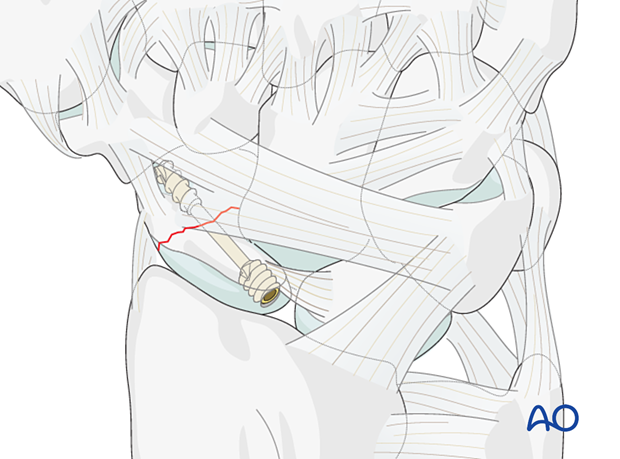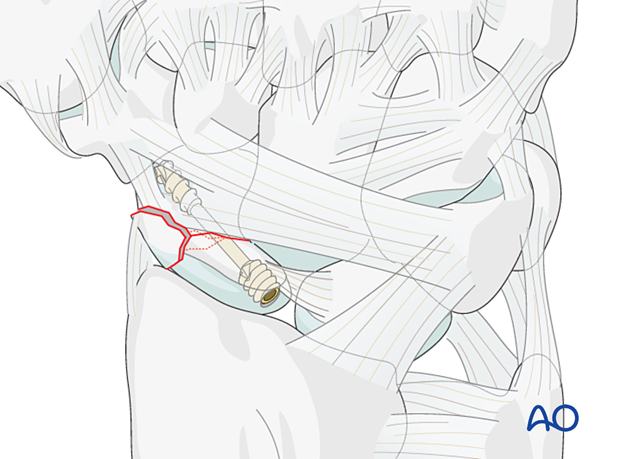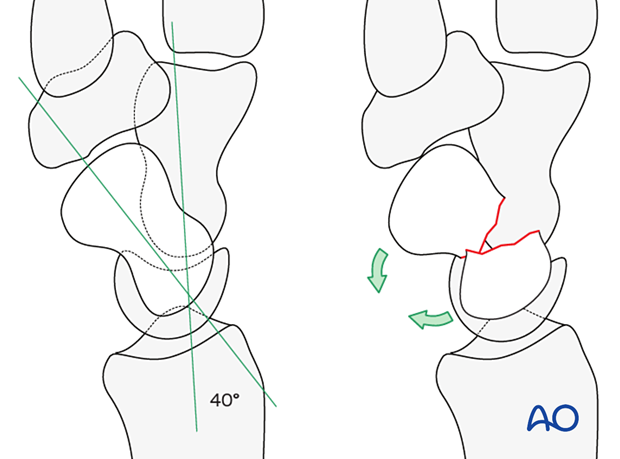ORIF through dorsal approach - Antegrade screw fixation
1. General considerations
Introduction
For the fixation of waist fractures of the scaphoid, headless compression screws (2.4 or 3.0 mm) may be used in an antegrade fashion through a dorsal approach.

Antegrade vs retrograde screw insertion
The anatomy of the carpus limits the positioning of fixation devices along the true central axis of the scaphoid. In proximal pole fractures and most waist fractures, an antegrade screw insertion using a dorsal approach allows for a more accurate and reliable center-axis screw placement.

This illustration shows the screw placement with a palmar approach.
Note the eccentric position of the screw within the scaphoid in the lateral view.

Arthroscopically assisted screw fixation
Alternatively, to an open dorsal approach, fracture management can be performed using arthroscopy, which helps control the reduction and can identify concomitant occult ligament injuries. This is technically demanding.
The thumb is usually in a finger trap for reduction with traction. If further reduction is needed, use percutaneous K-wires as joysticks and temporarily fix the fracture with a K-wire from proximal to distal.

Comminuted scaphoid fractures
In case of a wedge fracture or comminution, a temporary K-wire may help to maintain the anatomy during screw insertion.
It is recommended to remove this K-wire after fracture compression.

Anatomical considerations
80% of the surface of the scaphoid is covered with articular cartilage. This greatly limits potential points of entry for fixation devices.
An additional constraint is the curved shape of the scaphoid.
This means that a wire or fixation device along the true central axis of the scaphoid is not possible from a palmar approach. Occasionally, access to a distal entry point for a device can only be gained by a limited excavation of the edge of the trapezium.

Fracture displacement forces
In displaced fractures of the waist of the scaphoid, the distal pole tends to rotate into flexion in relation to the proximal pole, the lunate, and the triquetrum, which lie in extension. This can create a rotational and angular deformity at the fracture site – the so-called “humpback deformity.”

Preoperative planning
Conventional radiographs do not adequately demonstrate the complete fracture configuration. A CT scan is recommended to reveal the degree of displacement.

2. Patient preparation
The patient is usually supine with the arm on a radiolucent side table.

3. Approach
Dorsal approach
Perform a straight dorsal skin incision, starting over Lister’s tubercle, and extending distally for about 3–4 cm.

4. Reduction
Inspection of the fracture
Look for additional lesions, especially scapholunate ligament ruptures.
The picture shows a proximal pole fracture combined with a complete scapholunate rupture. The head of the capitate is visible deeper in the wound. The proximal pole fragment has been delivered into the wound and has no soft-tissue attachments to the remaining carpus. Its vitality is therefore in question.

Reduction
If the fracture is displaced, reduce it with small pointed reduction forceps.

5. Guide-wire insertion
The entry point is at the proximal pole, directly adjacent to the scapholunate ligament insertion.
Insert the guide wire in the axis of the shaft of the first metacarpal, in radial abduction.

Confirm accurate advancement of the guide wire in the scaphoid axis with an image intensifier in at least two planes and perpendicular to the fracture plane.
Do not penetrate the scaphotrapezial joint with the guide wire.

6. Screw insertion
Insert the headless compression screw in a standard manner.
Select a screw 2–4 mm shorter than the measured length with the appropriate thread length. In most cases, a 16–20 mm cannulated screw is the appropriate length.

Confirming screw position
Check the final position of the screw and the scaphoid stability with an image intensifier.

Case with antegrade screw fixation of a scaphoid waist fracture

7. Aftercare
The aftercare can be divided into four phases of healing:
- Inflammatory phase (week 1–3)
- Early repair phase (week 4–6)
- Late repair and early tissue remodeling phase (week 7–12)
- Remodeling and reintegration phase (week 13 onwards)
Full details on each phase can be found here.
Pain control
To facilitate rehabilitation, it is important to control the postoperative pain adequately.
- Management of swelling
- Appropriate splintage
- Appropriate oral analgesia
- Careful consideration of peripheral nerve blockade
Immediate postoperative treatment
Immobilize the wrist with a well-padded below-elbow splint for 2 weeks.
Splinting helps with soft-tissue healing, especially of the ligaments cut during a palmar approach.













